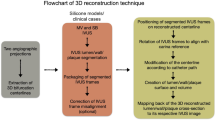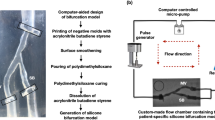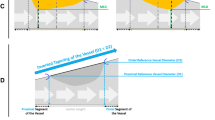Abstract
The geometry of coronary arteries affects regional atherogenic processes. Accurate images can be assessed using multislice computer tomography (MSCT) to estimate bifurcations angles. We propose a three-dimensional (3D) method to measure true bifurcation angles of coronary arteries and to determine possible correlations between plaque presence and angulations. The left main (LM) coronary artery, left anterior descendent (LAD) and left circumflex artery (LCX) were imaged in 40 atherosclerotic and 35 healthy patients, using 64-rows MSCT. This Y-junction was simplified fitting a 3D cylinder to each vessel to estimate true bifurcation angles and diameters. The method was tested in phantoms and interobserver variability was assessed. Geometrical results were compared between groups using an unpaired t-test. The cylinders fitted reasonably well with mean distances to measured points below 0.4 mm. LAD–LCX bifurcation angles were wider in the atherosclerotic group (p < 0.01). LAD (p < 0.01) and LCX (p < 0.05) diameters were also larger. In phantoms mean absolute difference between true and estimated angles (N = 27) was 0.44 ± 0.54°. Interobserver mean difference (N = 135) was 1.8 ± 5.8°. Simplifying coronary bifurcation with cylinders results in a reliable technique to assess coronary artery geometry in 3D, avoiding planar projections and decreasing interobserver variability. Geometrical risk factors should be incorporated to properly predict atherosclerosis processes.




Similar content being viewed by others
References
Bachar GN, Atar E, Fuchs S, Dror D, Kornowski R. Prevalence and clinical predictors of atherosclerotic coronary artery disease in asymptomatic patients undergoing coronary multidetector computed tomography. Coron Artery Dis. 2007;18:353–60.
Brinkman AM, Baker PB, Newman WP, Vigorito R, Friedman MH. Variability of human coronary artery geometry: an angiographic study of the left anterior descending arteries of 30 autopsy hearts. Ann Biomed Eng. 1994;22:34–44.
Chen SYJ, Carroll JD, Messenger JC. Quantitative analyses of reconstructed 3-D coronary arterial tree and intracoronary devices. IEEE Trans Med Imaging. 2002;21:724–40.
De Syo D, Franjić BD, Lovricević I, Vukelić M, Palenkić H. Carotid bifurcation position and branching angle in patients with atherosclerotic carotid disease. Coll Antropol. 2005;29:627–32.
Ding Z, Biggs T, Seed WA, Friedman MH. Influence of the geometry of the left main coronary artery bifurcation on the distribution of sudanophilia in the daughter vessels. Arter Thromb Vasc Biol. 1997;17:1356–60.
Ferencik M, Nomura CH, Maurovich-Horvat P, Hoffmann U, Pena AJ, Cury RC, et al. Quantitative parameters of image quality in 64-slice computed tomography angiography of the coronary arteries. Eur J Radiol. 2006;57:373–9.
Friedman MH. Variability of 3D arterial geometry and dynamics, and its pathologic implications. Biorheology. 2002;39:513–7.
Friedman MH, Deters OJ, Mark FF, Bargeron CB, Hutchins GM. Arterial geometry affects hemodynamics. A potential risk factor for atherosclerosis. Atherosclerosis. 1983;46:225–31.
Friedman MH, Baker PB, Ding Z, Kuban BD. Relationship between the geometry and quantitative morphology of the left anterior descending coronary artery. Atherosclerosis. 1996;125:183–92.
Gibson CM, Diaz L, Kandarpa K, Sacks FM, Pasternak RC, Sandor T, et al. Relation of vessel wall shear stress to atherosclerosis progression in human coronary arteries. Arter Thromb Vasc Biol. 1993;13:310–5.
Goubergrits L, Affeld K, Fernandez-Britto J, Falcon L. Atherosclerosis in the human common carotid artery. A morphometric study of 31 specimens. Pathol Res Pract. 2001;197:803–9.
Hutchins GM, Miner MM, Boitnott JK. Vessel caliber and branch-angle of human coronary artery branch-points. Circ Res. 1976;38:572–6.
Ikeda U, Kuroki M, Ejiri T, Hosoda S, Yaginuma T. Stenotic lesions and the bifurcation angle of coronary arteries in the young. Jpn Heart J. 1991;32:627–33.
Kimura BJ, Russo RJ, Bhargava V, McDaniel MB, Peterson KL, DeMaria AN. Atheroma morphology and distribution in proximal left anterior descending coronary artery: in vivo observations. J Am Coll Cardiol. 1996;27:825–31.
Lagarias JC, Reeds JA, Wright MH, Wright PE. Convergence properties of the Nelder-Mead simplex method in low dimensions. SIAM J Optim. 1998;9:112–47.
Lefevre T, Louvard Y, Morice MC, Loubeyre C, Piechaud JF, Dumas P. Stenting of bifurcation lesions: a rational approach. J Interv Cardiol. 2001;14:573–85.
Messenger JC, Chen SY, Carroll JD, Burchenal JE, Kioussopoulos K, Groves BM. 3D coronary reconstruction from routine single-plane coronary angiograms: clinical validation and quantitative analysis of the right coronary artery in 100 patients. Int J Card Imaging. 2000;16:413–27.
Murray CD. The physiological principle of minimum work applied to the angle of branching arteries. J Gen Physiol. 1926;9:835–41.
O’Flynn PM, O’Sullivan G, Pandit AS. Methods for three-dimensional geometric characterization of the arterial vasculature. Ann Biomed Eng. 2007;35:1368–81.
Pflederer T, Ludwig J, Ropers D, Daniel WG, Achenbach S. Measurement of coronary artery bifurcation angles by multidetector computed tomography. Invest Radiol. 2006;41:793–8.
Ravensbergen J, Ravensbergen JW, Krijger JK, Hillen B, Hoogstraten HW. Localizing role of hemodynamics in atherosclerosis in several human vertebrobasilar junction geometries. Arter Thromb Vasc Biol. 1998;18:708–16.
Reig J, Petit M. Main trunk of the left coronary artery: anatomic study of the parameters of clinical interest. Clin Anat. 2004;17:6–13.
Rodriguez-Granillo GA, Rosales MA, Degrossi E, Durbano I, Rodriguez AE. Multislice CT coronary angiography for the detection of burden, morphology and distribution of atherosclerotic plaques in the left main bifurcation. Int J Cardiovasc Imaging. 2007;38:389–92.
Smedby O. Geometrical risk factors for atherosclerosis in the femoral artery: a longitudinal angiographic study. Ann Biomed Eng. 1998;26:391–7.
Soulis JV, Farmakis TM, Giannoglou GD, Louridas GE. Wall shear stress in normal left coronary artery tree. J Biomech. 2006;39:742–9.
Sun H, Kuban BD, Schmalbrock P, Friedman MH. Measurement of the geometric parameters of the aortic bifurcation from magnetic resonance images. Ann Biomed Eng. 1994;22:229–39.
Wischgoll T, Choy JS, Ritman EL, Kassab GS. Validation of image-based method for extraction of coronary morphometry. Ann Biomed Eng. 2008;36:356–68.
Zamir M. Three-dimensional aspects of arterial branching. J Theor Biol. 1981;90:457–76.
Zeina AR, Rosenschein U, Barmeir E. Dimensions and anatomic variations of left main coronary artery in normal population: multidetector computed tomography assessment. Coron Artery Dis. 2007;18:477–82.
Acknowledgment
We would like to thank Cecile Redon and Fedra Ameneiro for their support with semiautomatic measurements.
Author information
Authors and Affiliations
Corresponding author
Appendix
Appendix
The problem of fitting a cylinder involves fitting a centerline (CL) and the radius (R) to the set of candidate points for each segment. A line in 3D can be defined as
where \( \vec{v} \) is the direction vector, P is some point on the line and \( \lambda \) is an arbitrary real scalar. The orthogonal projection (OP) of each candidate point (CP) to the unknown centerline can be calculated with a scalar product as (See Fig. 5):
Using (1), OP belongs to the centerline, thus replacing in (2)
and λ value for can be isolated:
The distance d from CP to OP can be calculated as
To reduce the number of free variables, we imposed the arbitrary point P on centerlines to reside in the \( z = 0 \) plane: \( P = \left( {P_{x} ,P_{y} ,0} \right) \) and the z component of the direction vector to be 1: \( \vec{v} = \left( {v_{x} ,v_{y} ,1} \right). \) Therefore, two redundant parameters were eliminated. Finally, a sum function of distances to the hypothetical cylinder of radius R was constructed and minimized using the simplex method developed by Nead and Melder (Lagarias et al. 1998) that can be found in MATLAB® fminsearch function. A root-mean square error (RMS) of approximating a cylinder to a vessel was defined as
where N is the number of candidate points and CYL p is the closest point in the cylinder from CP, orthogonal to its centerline. After cylinders determination (with direction vectors \( \vec{v}_{1} ,\vec{v}_{2} , \)) the true angle in 3D between a pair of centerlines (\( \theta \)) was analytically calculated using the following formula:
Rights and permissions
About this article
Cite this article
Craiem, D., Casciaro, M.E., Graf, S. et al. Coronary Arteries Simplified with 3D Cylinders to Assess True Bifurcation Angles in Atherosclerotic Patients. Cardiovasc Eng 9, 127–133 (2009). https://doi.org/10.1007/s10558-009-9084-1
Received:
Accepted:
Published:
Issue Date:
DOI: https://doi.org/10.1007/s10558-009-9084-1





